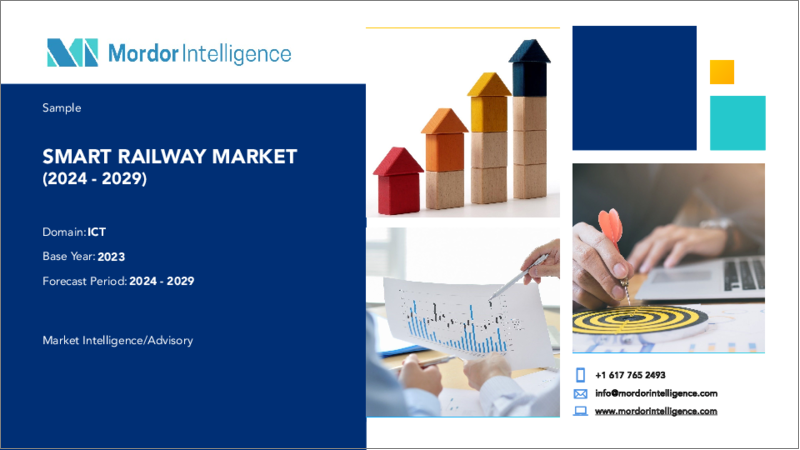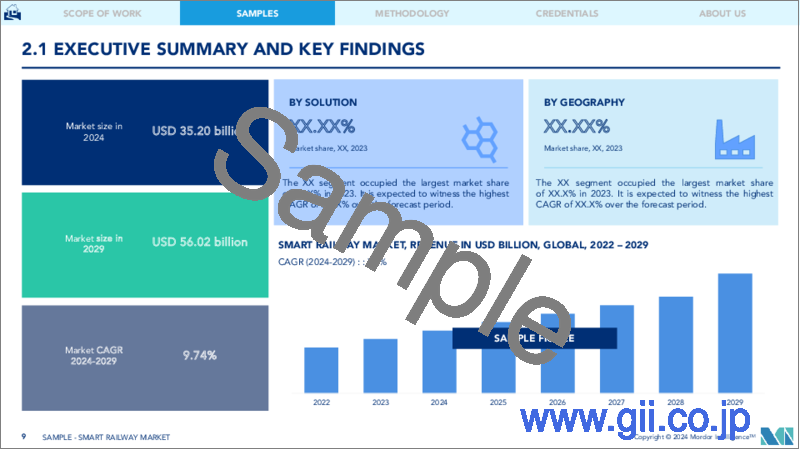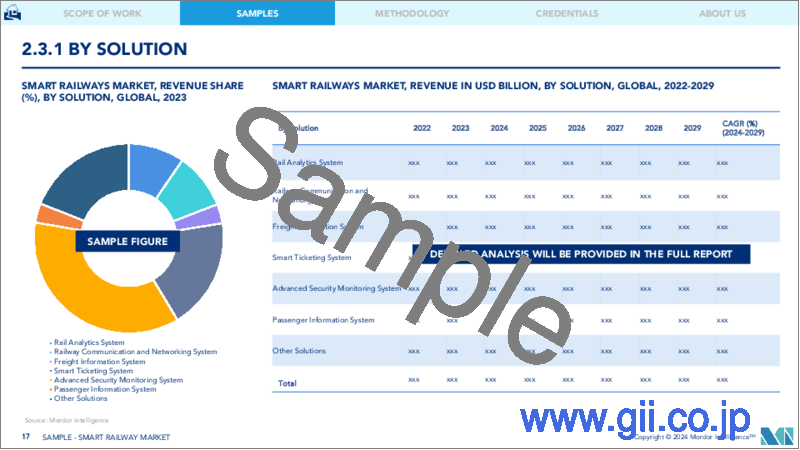|
|
市場調査レポート
商品コード
1403932
スマート鉄道 - 市場シェア分析、産業動向・統計、2024年~2029年成長予測Smart Railways - Market Share Analysis, Industry Trends & Statistics, Growth Forecasts 2024 - 2029 |
||||||
|
● お客様のご希望に応じて、既存データの加工や未掲載情報(例:国別セグメント)の追加などの対応が可能です。 詳細はお問い合わせください。 |
|||||||
| スマート鉄道 - 市場シェア分析、産業動向・統計、2024年~2029年成長予測 |
|
出版日: 2024年01月04日
発行: Mordor Intelligence
ページ情報: 英文 130 Pages
納期: 2~3営業日
|
- 全表示
- 概要
- 目次
スマート鉄道市場規模は2024年に352億米ドルと推計され、2029年には560億2,000万米ドルに達すると予測され、予測期間中(2024年~2029年)のCAGRは9.74%で成長する見込みです。
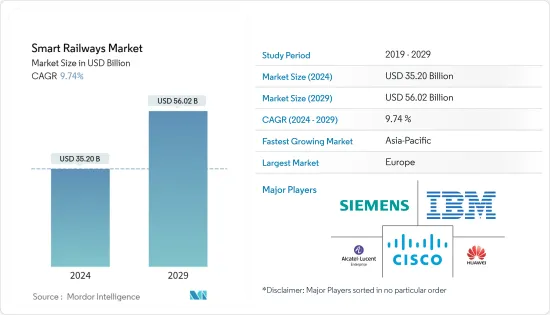
貨物輸送と都市モビリティに対する需要の増大は、鉄道運営に対する新たなアプローチを必要としています。世界の鉄道市場は着実な拡大を続けると予測され、なかでも都市交通が最も急速に拡大しています。この急成長と制限されたネットワークは、次世代の旅客・貨物ニーズに応えようとする鉄道事業者に多大な負担を強いています。
主なハイライト
- 都市間接続のニーズの高まり、IoTベースの技術統合の進展、排出量削減の重視はすべて、「スマート鉄道」システムの出現に拍車をかける可能性が高いです。IBEFによると、インド国鉄は信号や通信などの技術を開発・創造しており、1万5,000kmが自動信号システムに、3万7,000kmが国産の列車衝突回避システム「KAVACH」を導入しています。
- 鉄道利用者の増加と利用者からの収入の増加に伴い、スマート鉄道市場は鉄道輸送量の増加に対応するために成長すると予想されます。例えば、IBEFによると、インド全土の鉄道旅客輸送による収益額は、以前の20億3,000万米ドルから2022年(2022年3月まで)には46億6,000万米ドルに増加しました。また、2023年(2022年10月まで)の旅客輸送量は36億1,000万人に達しました。
- さらに、不必要な交通渋滞を避けるための時間効率の良い代替手段として、都市部の乗客は鉄道通勤に傾倒しています。したがって、毎日の通勤で鉄道を利用する都市部の乗客の信頼性が高まることは、スマート鉄道市場の成長に大きく寄与します。
- 鉄道会社はまた、過去のビッグデータリソースを活用して予防的モデリングを可能にし、機械学習を使って斬新な方法で問題に取り組んでいます。鉄道事業者は革新的な技術を活用し、 促進要因・マシン・インターフェースやインフォテインメントなどの統合デジタル体験を提供することで、乗客と 促進要因の体験と効率を向上させています。
- スマート・トレイン・システムの開発には、多額の初期インフラ投資が必要です。最新技術の採用により、スマート鉄道路線の展開には多額の出費が必要となります。特に有線イーサネット・ネットワークでは、設置費用がかさむため、ネットワーク接続のために列車をケーブルで接続するのは高価です。さらに、列車を改造するたびに配線をやり直す必要があり、メンテナンス費用がかさみます。さらに、技術的なミスや統合の難しさによって、設置後にインフラ部品が故障すると、人命の損失や多額の交換費用など、深刻な影響が生じる可能性があります。したがって、導入の初期コストが高いことが、世界のスマート鉄道システム市場を制限すると予測されます。
- COVID-19後のシナリオでは、生体認証、統合型、非接触型&モバイル決済の採用、センサーベース技術、公共交通機関全体の発券技術に対する需要の高まりによって、市場の見通しはプラスの影響を受けました。さらに、さまざまな企業による開発も、スマート鉄道の需要を押し上げると予想されます。
スマート鉄道市場の動向
超都市人口の増加が市場を牽引
- 超都市化と世界化による人口増加により、世界の都市はスマート化しています。コネクテッド・テクノロジーとスマート・サービスは、都市サービスの品質、効率、双方向性を向上させ、リソースを最適化し、コストを削減することで、都市の変革に重要な役割を果たしています。シスコによると、IoTアプリケーションをサポートするマシン・ツー・マシン接続は、2022年には世界のコネクテッド・デバイス285億台の半分以上を占める。
- 旅客と貨物の増加が予想される中、世界の都市人口の拡大により、鉄道がインテリジェント・ソリューションを適用する需要が高まると予想されます。人口問題研究所によると、2022年の世界の都市化率は57%だった。北米は最も都市化が進んだ地域で、人口の5分の4以上が都市部に住んでいます。
- さらに、国連経済社会局によると、2050年までに世界人口の68%が都市部に住むようになると予想されています。この増加の90%は、アフリカとアジアが占めると予想されています。インドなど特定の国では、毎時60人が都市に移動しています。
- スマート鉄道サービスは、拡大する人口の問題に取り組む上で極めて重要です。スマート鉄道は、大容量で安全、かつ低排出の代替手段を都市大量輸送に提供するため、将来を見据えた選択肢となります。郊外の人々を大都市圏に送迎するための持続可能な選択肢を提供するだけでなく、そう遠くない将来、フェリーや空港、宇宙港といった他の重要な交通拠点に頻繁に接続するようになります。スマートシティは、自律走行、オンデマンド、ネットワーク化された鉄道サービスによって、より持続可能なものになるかもしれないです。
- 鉄道は、大勢の人々を迅速かつ確実に移動させる安全で効率的な手段であり、現代の洗練された鉄道システムは、より経済的に持続可能で、生態学的にも有益なものに進化しています。革新的な鉄道は、エンド・ツー・エンドの複合輸送サービスの重要な要素です。
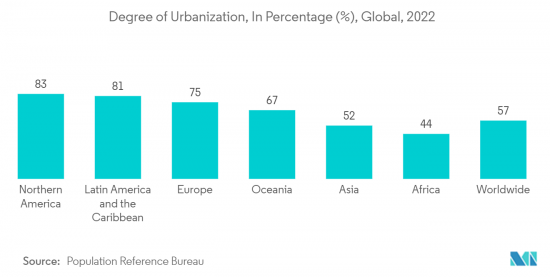
アジア太平洋が大きな市場シェアを占めると予想される
- アジア太平洋における都市内ネットワークの拡大、デジタルサイネージ、スマートチケッティング、Wi-Fi接続店舗による娯楽オプションの追加や生産性の向上が、同地域におけるスマート鉄道の採用を促進すると予測されます。さらに、デジタル・インディア構想の一環として、インド政府は国内でのIoT推進を計画しています。同政府は、交通の制御、水と電力の効率的な利用、ヘルスケアやその他のサービスのためのIoTセンサーを使ったデータ収集など、IoTデバイスを動力源とする100のスマートシティを開発するために、7,000カロールインドルピー(853億2,000万米ドル)の基金を割り当てた。
- 中国の巨大な鉄道は、国や都市の交通インフラにとって不可欠であり、すでに世界トップクラスのシステムを有しています。例えば、中国には世界最大の高速鉄道網があり、その総延長は37,000km(22,990マイル)を超え、世界の高速鉄道網の64%を占めています。
- さらに、この地域では、各政府が既存の路線を「アップグレード」「刷新」し、全体的な運行効率を向上させるために相当な努力を払ってきました。さらに、メガシティの開発は、アジア太平洋の新興諸国で最も強力に進むと予測されています。
- インド・ブランド・エクイティ財団によると、インド鉄道への投資額は2018年から2022年の間に約1,240億米ドルに達しました。このような鉄道開発への巨額投資は、この地域におけるスマート鉄道ソリューションの需要をさらに押し上げると思われます。さらに、政府は2022年8月、速度向上のためのミッション・ラフタールを開始し、貨物列車の中間速度を2倍にし、郵便/超高速/特急列車の平均速度を時速25km向上させるという目標を達成しました。
- 2022年11月、日本企業のコンソーシアムは、民間5Gネットワーク用のオープンソースソフトウェアを作成し、民間インフラのコストを削減する低コストの5Gコア(5GC)ネットワークを国内で提供するとしています。さらに、2022年8月には、IBM Corp.とVMware Inc.が、顧客の情報技術近代化イニシアチブを支援するために提携を拡大しました。
- 2022年1月、中国-ラオス鉄道の開通により、中国の世界な鉄道インフラが構築され、線路とコンクリートを使用してより高速なデジタル通信ネットワークが提供されるようになった。ファーウェイのスマート鉄道ソリューションは、中国とラオスの新しい鉄道リンクで使用されており、ファーウェイはラオスの通信プロバイダーと協力して、高速沿線に高速ネットワークを構築しています。旅行者や農村部の住民は、その信頼性の高い接続性から恩恵を受けると思われます。
- 革新的な鉄道ソリューションを導入して鉄道を開発・強化するために、政府や地域プレーヤーが継続的に行っているこうした投資は、本市場の成長を後押しすると思われます。
スマート鉄道産業の概要
スマート鉄道市場は、シスコシステムズ、IBMコーポレーション、ALEインターナショナル、ファーウェイ・テクノロジーズ、シーメンスAGなどの主要企業が参入しており、非常に細分化されています。同市場のプレーヤーは、製品提供を強化し、持続可能な競争優位性を獲得するために、提携、協力、買収などの手法を採用しています。
- 2022年6月- ファーウェイは光トランスポートネットワークの新ビジョンを発表しました。この新ビジョンは、光トランスポートネットワーク(OTN)をエッジノードに提供し、全方位的なプレミアム接続を提供し、環境に優しく分かりやすい光ネットワークを構築し、事業者の財務的成功を支援することに主眼を置いています。
- 2022年3月- シスコとネットワーク・レール・テレコム(NRT)は、駅構内を走る政府所有のファイバーとサードパーティの無線を活用し、地域社会に通信と接続性を提供するために協力。英国国民保健サービスは、遠隔診察、検査、診断のための遠隔健康ポッドを設置することができました。これは、鉄道技術がいかに良い方向に利用されているかを示す一例です。このポッドキャストでは、鉄道技術に関するあらゆる機会を取り上げています。これには、従業員や乗客のためのスマート鉄道の利点や、鉄道の運行と管理を改善するための継続的な協力が含まれます。
その他の特典
- エクセル形式の市場予測(ME)シート
- 3ヶ月間のアナリスト・サポート
目次
第1章 イントロダクション
- 調査の前提条件と市場定義
- 調査範囲
第2章 調査手法
第3章 エグゼクティブサマリー
第4章 市場洞察
- 市場概要
- 業界の魅力度-ポーターのファイブフォース分析
- 新規参入業者の脅威
- 買い手の交渉力
- 供給企業の交渉力
- 代替品の脅威
- 競争企業間の敵対関係
- マクロ経済動向の市場への影響
- バリューチェーン分析
第5章 市場力学
- 市場促進要因
- スマートシティの重要性の高まり
- 超都市化による人口増加
- 市場抑制要因
- レガシーシステムへの統合と接続性の問題、初期インフラと関連投資の高さ
第6章 市場セグメンテーション
- ソリューション別
- 鉄道分析システム
- 鉄道通信・ネットワークシステム
- 貨物情報システム
- スマートチケッティングシステム
- 高度セキュリティ監視システム
- 旅客情報システム
- その他のソリューション
- 地域別
- 北米
- 欧州
- アジア太平洋
- ラテンアメリカ
- 中東・アフリカ
第7章 競合情勢
- 企業プロファイル
- Cisco Systems Inc.
- IBM Corporation
- ALE International
- Huawei Technologies Co. Ltd
- Siemens AG
- Hitachi Ltd
- Tata Consultancy Services Limited
- Moxa Inc.
- Thales Group
- Televic Group
- Cyient Limited
- Toshiba Corporation
第8章 投資分析
第9章 市場の将来

The Smart Railways Market size is estimated at USD 35.20 billion in 2024, and is expected to reach USD 56.02 billion by 2029, growing at a CAGR of 9.74% during the forecast period (2024-2029).
Increasing demand for freight transportation and urban mobility necessitates new approaches to railway operations. The worldwide rail market is predicted to continue its steady expansion, with urban transportation experiencing the fastest increase. This fast growth and a restricted network place tremendous strain on railway operators attempting to meet the next generation of passenger and freight needs.
Key Highlights
- The growing need for urban connectivity, more integration of IoT-based technology, and a strong emphasis on lowering emissions are all likely to fuel the emergence of the "smart railway" system. In addition, According to IBEF, Indian Railways is developing and creating technology in places such as signaling and telecommunication, with 15,000 km being transformed into automatic signaling and 37,000 km being fitted with 'KAVACH,' the domestically generated Train Collision Avoidance System.
- With growing numbers of railway passengers and revenue from passengers, the smart railways market is expected to grow to handle the increased rail traffic. For instance, according to IBEF, the value of earnings from rail passenger traffic across India increased from USD 2.03 billion previously to USD 4.66 billion in 2022 (till March 2022). In addition, In 2023 (until October 2022), passenger traffic stood at 3.61 billion.
- Moreover, urban passengers are more inclined toward rail commutes, as it serves as a time-effective alternative to avoid unnecessary traffic congestion. Thus, an increase in the reliability of urban passengers on railways for daily commutes significantly contributes toward the growth of the smart railway market.
- Railroads are also leveraging historical big data resources to allow preventive modeling and use machine learning to tackle problems in novel ways. Operators are leveraging innovative technology to give integrated digital experiences, such as driver-machine interface and infotainment, to improve passenger and driver experiences and efficiency.
- The substantial initial infrastructure expenditure required stymies the development of smart train systems. Due to the employment of modern technology, the deployment of smart railway lines necessitates substantial expenditure. Cabling a train for network connectivity is expensive, especially over a wired Ethernet network, due to the high installation expenses. Additionally, rewiring may be required each time the train is modified, raising maintenance expenses. Moreover, failure of any infrastructure part after installation due to a technical error or integration difficulty can have severe effects, including loss of life and considerable replacement expenses. Hence, it is predicted that the high initial cost of implementation will limit the worldwide smart railway systems market.
- In the post-COVID-19 scenario, the market outlook was positively impacted by rising demand for biometric, integrated, contactless & mobile payment adoption, sensor-based technology, and ticketing technologies throughout public transit. Moreover, the development by various companies is also expected to boost the demand for smart railways.
Smart Railways Market Trends
Increasing Hyper-urban Population to Drive the Market
- Cities worldwide have become smarter due to the increased population of hyper-urbanization and globalization. Connected technologies and Smart services play critical roles in urban transformation by improving urban services' quality, efficiency, and interactivity, optimizing resources, and lowering costs. According to Cisco, machine-to-machine connections supporting IoT applications accounted for over half of the world's 28.5 billion connected devices in 2022.
- With the expected increase in passengers and freights, the worldwide urban population expansion is expected to enhance the demand for railways to apply intelligent solutions. According to Population Reference Bureau, in 2022, the degree of urbanization worldwide was 57%. North America was the region with the highest level of urbanization, with over four-fifths of the population living in urban areas.
- Further, according to the United Nations Department of Economic and Social Affairs, 68% of the world's population is anticipated to live in urban areas by 2050. Africa and Asia are expected to contribute to 90% of this increase. In certain countries, including India, up to 60 individuals move into cities every hour.
- Smart rail service will be critical in tackling the problems of an expanding population. A smart rail is a future-proofing option as it delivers a high-capacity, safe, low-emission alternative for urban mass transit. It not only provides a sustainable option for carrying suburban people to and from metropolitan regions, but it also frequently connects to other vital transportation hubs such as ferries, airports, and spaceports in the not-too-distant future. Smart cities may become more sustainable with autonomous, on-demand, and networked train services.
- Rail is a safe, efficient means to move large groups of people swiftly and reliably, and contemporary, sophisticated train systems are evolving to be more economically sustainable and ecologically beneficial. Innovative rail is a critical component of end-to-end multimodal service..

Asia Pacific is Expected to Hold the Significant Market Share
- The expansion of an intracity network in Asia-Pacific and digital signage, smart ticketing, and Wi-Fi connectivity stores that provide additional entertainment options or increased productivity are projected to drive the region's adoption of smart railways. Furthermore, as part of the Digital India initiative, the Indian government has planned to push IoT in the country. The government allocated an INR 7,000 crore (USD 85.32 billion) fund to develop 100 smart cities powered by IoT devices to control traffic, efficiently use water and power, and collect data using IoT sensors for healthcare and other services.
- China's enormous railways are essential to the country's national and urban transportation infrastructures, and the country already has some world-class systems. China, for example, has the world's largest high-speed rail network, reaching over 37,000 km (22,990 miles) and accounting for 64% of global high-speed networks.
- Furthermore, in this region, the respective governments have made considerable efforts to "upgrade" and "revamp" existing lines to improve overall operating efficiency. Furthermore, the development of megacities is predicted to be strongest in emerging Asia-Pacific countries.
- According to the India Brand Equity Foundation, investment in Indian railways amounted to approximately USD 124 billion between 2018 and 2022. Such massive investment in the development of railways would further boost the demand for smart railway solutions in the region. In addition, in August 2022, the government launched Mission Raftaar for speed enhancement and to achieve a target of doubling the intermediate speed of freight trains and enhancing the average speed of mail/superfast/express trains by 25 kmph.
- In November 2022, a consortium of Japanese firms produced open-source software for private 5G networks, claiming to provide a low-cost 5G core (5GC) network that reduces the cost of private infrastructure domestically. Furthermore, in August 2022, IBM Corp. and VMware Inc. expanded their partnership to assist their customers' information technology modernization initiatives.
- In January 2022, with the opening of the China-Laos railway, China's global railway infrastructure was being built, using tracks and concrete to deliver a faster digital communications network. Huawei's Smart Railway Solutions are used in the new China-Laos rail link, and Huawei is working with Laotian telecom providers to build a high-speed network along the high-speed line. Travelers and rural residents would benefit from its reliable connectivity.
- Such ongoing investments by the government and regional players to develop and strengthen the railways by deploying innovative railway solutions would boost the growth of the Market studied.
Smart Railways Industry Overview
The smart railways market is highly fragmented, with major players like Cisco Systems Inc., IBM Corporation, ALE International, Huawei Technologies Co. Ltd, and Siemens AG. Players in the Market are adopting techniques such as partnerships, collaborations, and acquisitions to enhance their product offerings and gain sustainable competitive advantage.
- June 2022 - Huawei announced its new vision for optical transport networks. This new vision is centered on delivering the optical transport network (OTN) to edge nodes to provide all-pervasive premium connectivity and construct eco-friendly and straightforward optical networks, assisting operators in achieving financial success.
- March 2022 - Cisco and Network Rail Telecom (NRT) collaborated to provide communications and connectivity to the community by utilizing government-owned fiber running through the station and third-party radios. The United Kingdom National Health Service was able to set up telehealth pods for remote consultations, testing, and diagnosis. It is one example of how rail technology is being used for the better. In this podcast, they look at all rail technology opportunities. This includes smart rail benefits for employees and passengers and ongoing collaborations to improve rail operations and management.
Additional Benefits:
- The market estimate (ME) sheet in Excel format
- 3 months of analyst support
TABLE OF CONTENTS
1 INTRODUCTION
- 1.1 Study Assumptions and Market Definition
- 1.2 Scope of the Study
2 RESEARCH METHODOLOGY
3 EXECUTIVE SUMMARY
4 MARKET INSIGHTS
- 4.1 Market Overview
- 4.2 Industry Attractiveness - Porter's Five Forces Analysis
- 4.2.1 Threat of New Entrants
- 4.2.2 Bargaining Power of Buyers
- 4.2.3 Bargaining Power of Suppliers
- 4.2.4 Threat of Substitutes
- 4.2.5 Intensity of Competitive Rivalry
- 4.3 Impact of Macroeconomic Trends on the Market
- 4.4 Value Chain Analysis
5 MARKET DYNAMICS
- 5.1 Market Drivers
- 5.1.1 Growing Importance of Smart Cities
- 5.1.2 Increasing Population Growth of Hyper-Urbanisation
- 5.2 Market Restraints
- 5.2.1 Issues with Integration and Connectivity into Legacy Systems and High Initial Infrastructure and Related Investments
6 MARKET SEGMENTATION
- 6.1 By Solution
- 6.1.1 Rail Analytics System
- 6.1.2 Railway Communication and Networking System
- 6.1.3 Freight Information System
- 6.1.4 Smart Ticketing System
- 6.1.5 Advanced Security Monitoring System
- 6.1.6 Passenger Information System
- 6.1.7 Other Solutions
- 6.2 By Geography
- 6.2.1 North America
- 6.2.2 Europe
- 6.2.3 Asia Pacific
- 6.2.4 Latin America
- 6.2.5 Middle East and Africa
7 COMPETITIVE LANDSCAPE
- 7.1 Company Profiles
- 7.1.1 Cisco Systems Inc.
- 7.1.2 IBM Corporation
- 7.1.3 ALE International
- 7.1.4 Huawei Technologies Co. Ltd
- 7.1.5 Siemens AG
- 7.1.6 Hitachi Ltd
- 7.1.7 Tata Consultancy Services Limited
- 7.1.8 Moxa Inc.
- 7.1.9 Thales Group
- 7.1.10 Televic Group
- 7.1.11 Cyient Limited
- 7.1.12 Toshiba Corporation
